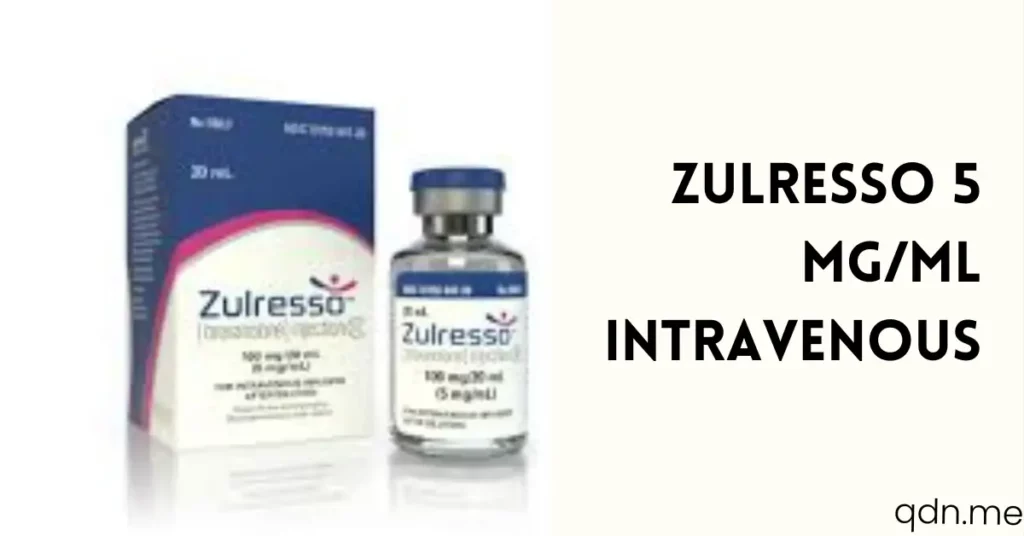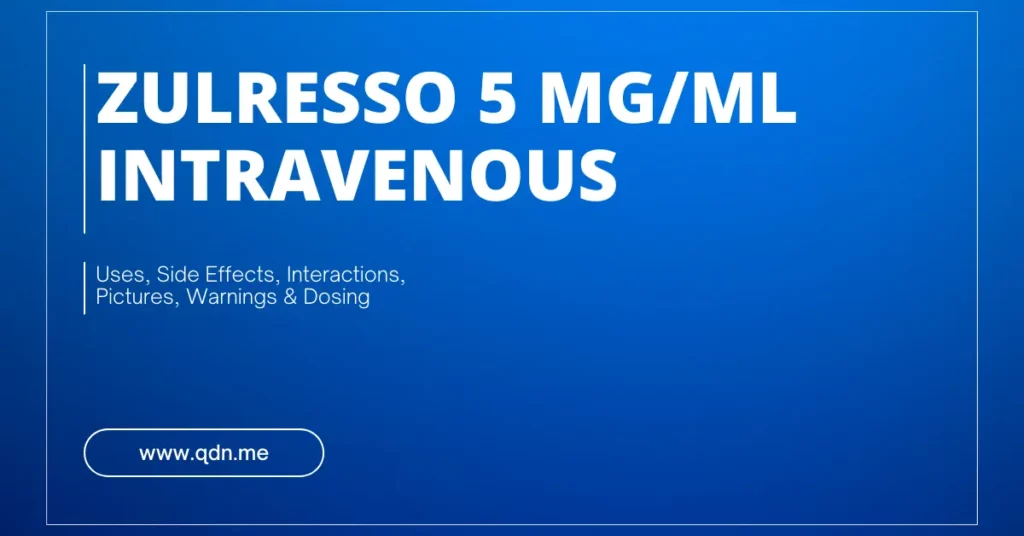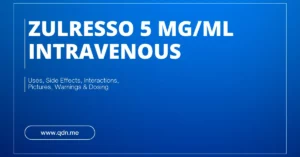Zulresso 5 Mg/Ml Intravenous: Uses, Side Effects, Interactions, Pictures, Warnings & Dosing

Zulresso Intravenous Solution is a medication that has been gaining popularity for the treatment of postpartum depression (PPD). Yet, not many people know much about it. In this blog, we aim to provide you with a comprehensive guide on Zulresso Intravenous Solution – from what it is and how it works to its uses, side effects, interactions with other medications, and more. We will cover everything from how it impacts the GABA-A receptor in the brain to its mechanism of action and dosage guidelines. We’ll also discuss alternatives to Zulresso as well as pregnancy and breastfeeding considerations. By the end of this article, you’ll have a better understanding of this medication’s efficacy in treating PPD and any other questions or concerns you may have about Zulresso will be answered.
Understanding Zulresso Intravenous Solution
Zulresso Intravenous Solution, a prescription medicine for postpartum depression, hasn’t been proven safe or effective in pediatric patients or for major depressive disorder. Administered as a continuous intravenous infusion over 60 hours, it’s only given in a healthcare facility. Animal studies indicate an increased risk with betadex sulfobutyl ether sodium. Sage Therapeutics advises seeking medical advice for untreated PPD. Zulresso impacts the activity of GABA, a neurotransmitter in the CNS, and affects progesterone and serotonin levels. This information is crucial for young adults considering Zulresso treatment.
Zulresso 5 Mg/Ml Intravenous: Uses, Side Effects, Interactions, Pictures, Warnings & Dosing
What is Zulresso?
Zulresso, also known as brexanolone, is a neuroactive steroid GABA-A receptor modulator. It is available as an intravenous solution for infusion. Follow your healthcare provider’s instructions for proper administration and monitoring during treatment with Zulresso.
The Role of Zulresso as a Neuroactive Steroid GABA-A Receptor Modulator
Zulresso modulates activity at the GABA-A receptor, linked to the neurotransmitter gamma-aminobutyric acid. Its mechanism of action in postpartum depression treatment is not fully understood, presenting a significant risk of adverse reactions, including suicidal thoughts and behaviors. Monitoring for suicidal ideation during and after administration is crucial. Healthcare providers must consider these potential risks when prescribing Zulresso. Sage Therapeutics conducted extensive animal studies to understand its impact, revealing an increased risk of suicidal thoughts and behaviors. It’s essential to seek medical advice if untreated PPD symptoms occur. Zulresso’s impact on the CNS, particularly serotonin and progesterone levels, underscores the need for close monitoring and care in young adults.
Uses of Zulresso
Zulresso provides a new treatment option for postpartum depression in adult women. As the first drug approved specifically for this condition, its benefits need to be carefully weighed against potential risks before use, especially since its safety and efficacy for postpartum psychosis have not been established. It’s important to note that Zulresso may not be suitable for individuals with an increased risk of adverse reactions, and medical advice should be sought before use. While it offers promise for untreated PPD, particularly in young adults, further research, including animal studies and consideration of progesterone and serotonin levels, is needed to fully understand its impact on the CNS and the activity of GABA.
Treatment of Postpartum Depression in Adult Women
Administered as a continuous intravenous infusion over 60 hours, Zulresso’s dosage and administration are tailored to the patient’s body weight. The clinical trials of Zulresso showcased its rapid and durable antidepressant effect, underscoring its potential in treating postpartum depression. Healthcare providers are urged to establish and maintain a postpartum depression registry program to monitor maternal and fetal outcomes closely. This registry is pivotal in recognizing any adverse effects and ensuring the safety of women undergoing treatment for postpartum depression. By adhering to these guidelines, healthcare professionals can better assess the impact and efficiency of this innovative treatment.
Other Potential Uses
Research into sage therapeutics’ Zulresso 5 Mg/Ml Intravenous Solution Neuroactive Steroid GABA-A Receptor Modulator Antidepressant is ongoing to explore its effects in other neurologic and psychiatric conditions. However, its use in patients with renal disease has not been studied. Healthcare providers should consider the drug’s betadex sulfobutyl ether sodium-based solubilizing agent and oral bioavailability in clinical studies. Additionally, the drug’s effects on breast milk production and its presence in breast milk are not known. Furthermore, animal studies have suggested an increased risk in untreated PPD. Patients are advised to seek medical advice regarding the potential uses of Zulresso in other conditions. Young adults and individuals with unresolved PPD may benefit from ongoing studies exploring the drug’s potential wider applications, which could potentially involve the activity of GABA, serotonin, and progesterone in the CNS.
Mechanism of Action of Zulresso
Sage Therapeutics’ Zulresso exerts its effects through positive allosteric modulation of the GABA-A receptor, enhancing inhibitory GABAergic transmission and extrasynaptic GABA receptor activity. Animal studies have shown that Zulresso administration leads to increased plasma levels of brexanolone and its metabolites, with significant differences in plasma levels in adult women. This highlights the increased risk and the need for careful evaluation before administration, emphasizing the importance of seeking medical advice. Understanding the activity of GABA and progesterone in the CNS is crucial for untreated PPD, especially in young adults, making it essential for healthcare providers to evaluate the clinical need for Zulresso.
Positive Allosteric Modulation
Zulresso serves as a positive allosteric modulator of both synaptic and extrasynaptic GABA-A receptors, necessitating close monitoring of its effects on blood pressure and gabaergic inhibition. The infusion of Zulresso may lead to dizziness and sleepiness, requiring patients to avoid operating machinery. Healthcare providers must advise against the use of benzodiazepines, such as alprazolam, during Zulresso infusion to mitigate the risk of cognitive impairment and drowsiness.
How Zulresso Impacts the GABA-A Receptor
Zulresso is believed to enhance the activity of gabaergic inhibition and extrasynaptic GABA, impacting the GABA-A receptor. Monitoring the drug’s effects on receptor activity and plasma levels is crucial and should be carefully managed. It’s essential to consider the impact of Zulresso administration on urine and feces disposal. Patients must be informed about the risk of serious side effects and adverse reactions, emphasizing the need for medical advice. Healthcare providers should educate patients about Zulresso, including its potential drug interactions and necessary precautions. The impact of Zulresso on animal studies, particularly regarding the increased risk and betadex sulfobutyl ether sodium, should be thoroughly evaluated to ensure the safety and efficacy of the treatment. Young adults, especially those with untreated PPD, may require additional monitoring due to the drug’s mechanism of action involving the CNS and serotonin.
Administering Zulresso
Zulresso administration requires careful monitoring and should be administered over a total infusion time of 60 hours, with the infusion rate gradually increasing to achieve the desired therapeutic effect. Healthcare facilities need to be equipped to manage any serious side effects, and the pharmacist and healthcare provider must follow the risk evaluation and mitigation strategy (REMS) for Zulresso administration. Adverse reactions and side effects during infusion need close observation, making medical advice crucial. Sage Therapeutics’ Zulresso presents an increased risk that needs to be managed appropriately, especially in young adults and untreated PPD cases. Animal studies have shown the impact of Zulresso on the activity of GABA-A receptors and its modulation of progesterone to alleviate PPD symptoms.
Dosage for Postpartum Depression (PPD)
The appropriate dosage of Zulresso for postpartum depression is determined based on your medical condition and response to treatment. Your healthcare provider will establish the suitable dosage and infusion duration for addressing your postpartum depression. Clinical trials have validated the efficacy and safety of Zulresso in treating postpartum depression. Administered as a continuous intravenous infusion over 60 hours, dosage adjustments may be needed depending on individual patient needs and tolerability. It is essential to adhere to medical advice regarding the dosage and infusion duration for the effective management of postpartum depression.
Guidelines for Long-Term Use
Long-term Zulresso use may be advised for patients with persistent postpartum depression symptoms. Your healthcare provider will evaluate the need for ongoing Zulresso treatment based on your response to initial therapy. Adherence to your healthcare provider’s guidelines for long-term Zulresso use is crucial. Regular monitoring and follow-up appointments are essential for managing long-term Zulresso administration. Careful evaluation of the benefits and potential risks is necessary for long-term Zulresso use.
The Cost of Zulresso
Understanding the cost of Zulresso treatment is crucial for informed healthcare decisions. Various factors such as insurance coverage, financial assistance, and healthcare facilities can influence the overall cost. The cost of Zulresso may vary based on the treatment duration, dosage requirements, and healthcare provider fees. Patients have resources for financial and insurance assistance to mitigate therapy costs. Accessing information on Zulresso’s cost can aid in planning postpartum depression treatment for patients and healthcare providers.
Financial and Insurance Assistance
Patients considering Zulresso treatment can explore available financial and insurance assistance programs to alleviate the potential financial burden. Eligible individuals may access Zulresso treatment at reduced or no cost through these programs. Information on financial and insurance assistance options for Zulresso can be obtained from healthcare facilities and specialty pharmacies. Understanding the eligibility criteria and application process for financial and insurance assistance is crucial for patients seeking Zulresso therapy. By inquiring about and exploring these resources, individuals can gain access to the necessary support to pursue Zulresso treatment without being hindered by financial constraints.
Side Effects of Zulresso
Zulresso may lead to specific side effects, which require discussion with your healthcare provider before beginning treatment. It’s crucial to understand the potential side effects of Zulresso for monitoring and managing postpartum depression therapy. Patients should be mindful of possible side effects linked to Zulresso and report any adverse reactions to their healthcare provider. Monitoring for side effects during and after Zulresso infusion is essential for ensuring patient safety and well-being. Your healthcare provider can offer comprehensive information on the side effects of Zulresso and strategies for addressing them.
More Common Side Effects
Dizziness, sleepiness, dry mouth, and injection site reactions are among the common side effects of Zulresso. It’s essential to communicate any discomfort to your healthcare provider and be aware that most patients tolerate these side effects without significant impairment in daily activities. Understanding the frequency and nature of these common side effects can help patients prepare for their Zulresso infusion experience. Your healthcare provider can offer guidance on managing and alleviating these more common side effects, ensuring a smoother treatment process.
Serious Side Effects
Patients must remain vigilant for any signs of serious side effects during and after Zulresso treatment, as these may require immediate medical attention. Although rare, Zulresso infusion can lead to serious side effects. Understanding the potential serious side effects is crucial for prompt recognition and intervention. It is essential to report any unusual or concerning symptoms to your healthcare provider to address the serious side effects of Zulresso. Your healthcare provider can discuss the risk of serious side effects associated with Zulresso and appropriate response measures. Being aware of the potential serious side effects and promptly seeking medical advice is vital for ensuring patient safety and well-being.
Side Effect Details
Comprehensive insights into the potential side effects of Zulresso can be obtained from your healthcare provider and drug information resources. Understanding the specific details of Zulresso’s side effects empowers patients to actively participate in their postpartum depression treatment. Side effect details encompass the frequency, severity, and duration of adverse reactions associated with Zulresso infusion. Seeking personalized insights from your healthcare provider can help you make informed healthcare decisions based on your medical history and individual risk factors. This information allows patients to have a better understanding of the potential impact on their health and make decisions accordingly.
Interactions of Zulresso
Zulresso, a neuroactive steroid GABA-A receptor modulator used in postpartum depression treatment, may interact with other medications, impacting its efficacy and safety. Patients must disclose all prescription drugs, over-the-counter medications, and supplements to their healthcare provider before receiving Zulresso to prevent adverse drug interactions. Consulting with a healthcare provider can help assess potential interactions of Zulresso with other medications in the treatment regimen. Tailored guidance on managing potential drug interactions with Zulresso can be provided by your healthcare provider. Understanding these interactions is crucial for the safe and effective use of Zulresso in postpartum depression treatment.
Zulresso and Other Medications
Zulresso’s interactions with other medications may require dosage adjustments or close monitoring of treatment outcomes. Certain medications, like alprazolam, may interact with Zulresso, demanding careful clinical vigilance. Healthcare providers should assess potential interactions based on individual patient characteristics. Understanding these implications is crucial for optimizing postpartum depression therapy. Patients on Zulresso should maintain open communication with their healthcare provider regarding concurrent medications and potential interactions.
Zulresso and Antidepressants
Zulresso, in contrast to oral antidepressants, is administered intravenously, offering a different mode of delivery for treating depression. Its mechanism of action differs significantly from traditional antidepressants, impacting the activity of GABA receptors in the central nervous system. Clinical trials have revealed variations in the side effects of Zulresso and oral antidepressants, emphasizing the need for careful assessment and medical advice. Understanding the potential interactions of Zulresso with oral antidepressants is crucial to mitigate the increased risk and ensure optimal treatment outcomes. Additionally, the administration and dosage of Zulresso differs from that of oral antidepressants, requiring tailored medical guidance for young adults and those with untreated PPD.
Alternatives to Zulresso
Various oral antidepressants serve as alternatives to Zulresso, including both traditional and newer medications. Understanding the differences in effectiveness and side effects between Zulresso and its alternatives is crucial. Healthcare providers can provide valuable information about alternative treatments to Zulresso, ensuring that patients receive personalized medical advice. Therefore, it is essential to consider the increased risk of untreated PPD and explore alternative options such as sage therapeutics and other antidepressants. Additionally, animal studies have indicated the potential of progesterone in the treatment of PPD, offering a promising alternative for young adults experiencing postpartum depression.
Zulresso vs. Zoloft
A direct comparison of Zulresso and Zoloft reveals differences in their administration methods and dosing regimens. The side effects of these medications also exhibit significant variations, as evidenced by clinical studies. Moreover, distinct drug interactions and warnings are associated with each drug. Understanding the disparities between Zulresso and Zoloft provides valuable insights into their individual efficacy and safety profiles. It is essential to consider these differences and similarities when making treatment decisions, especially for patients who may have specific medical considerations or are at an increased risk of adverse effects.
Zulresso vs. Lexapro
When considering Zulresso vs. Lexapro, it’s important to note the differences in drug administration and dosage forms for each medication. Clinical studies have indicated varying side effects and safety profiles between Zulresso and Lexapro. Additionally, the efficacy of these two drugs differs, highlighting variations in their impact on patients. It’s crucial to be aware of the distinct drug interactions and warnings associated with Zulresso and Lexapro. Healthcare facilities can offer valuable insights into the variations between these medications, guiding individuals in making informed treatment decisions.
Zulresso and Alcohol
Combining Zulresso and alcohol warrants consideration due to potential interactions on the central nervous system. Healthcare providers can offer guidance on using Zulresso and alcohol concurrently, considering the risk of increased adverse effects. Drug information should include warnings about alcohol consumption while using Zulresso, especially for young adults. Understanding the interactions between Zulresso and alcohol is crucial for medical advice, as it may impact the activity of GABA. Animal studies have suggested an increased risk when Zulresso is combined with alcohol, highlighting the need for caution. It’s essential to weigh the risks and side effects of combining Zulresso with alcohol and seek medical advice for appropriate management.
Risks and Warnings
Zulresso administration comes with specific risks and warnings that healthcare providers must communicate. Understanding the side effects and adverse reactions of Zulresso is crucial, as suicidal ideation and serious side effects pose significant risks. Monitoring adverse reactions and potential drug interactions with Zulresso is essential to ensure patient safety. Both patients and healthcare providers must be aware of the significant risks associated with Zulresso administration. Monitoring the activity of GABA, serotonin, and progesterone in the central nervous system is crucial to mitigate the increased risk. Additionally, Sage Therapeutics recommends seeking medical advice for young adults with untreated PPD. Animal studies have shown an increased risk when using Zulresso in conjunction with betadex sulfobutyl ether sodium or betadex sulfobutyl ether.
Zulresso During Pregnancy and Breastfeeding
Understanding the implications of Zulresso use during pregnancy is crucial, as it involves potential risks for the mother and the developing fetus. Additionally, a comprehensive evaluation of the effects of Zulresso on breast milk and breastfeeding is necessary to ensure the safety of the nursing infant. Healthcare providers play a vital role in informing patients about these potential risks and precautions when considering Zulresso treatment during pregnancy and while breastfeeding. Insights from registry data and clinical studies provide valuable information on the impact of Zulresso during pregnancy and breastfeeding. Drug information must include detailed warnings, precautions, and considerations for the use of Zulresso in pregnant and breastfeeding individuals.
What You Should Know
Patients should be well-informed about the use of Zulresso and its potential effects, including the risk of drowsiness and impairment. Understanding the side effects and post-administration considerations of Zulresso is crucial for both patients and caregivers. Additionally, discussions about Zulresso usage should cover its effects on sleepiness and alertness. Pharmacist guidance and patient education play a crucial role in preparing individuals for what to expect after Zulresso administration. It’s essential to recognize the increased risk associated with Zulresso and seek medical advice when necessary, especially for young adults. Furthermore, considering the activity of GABA and serotonin, as well as the impact of progesterone, can provide a comprehensive understanding of Zulresso’s effects.
Understanding the Efficacy of Zulresso
Clinical trials offer valuable insights into the safety and efficacy of Zulresso, providing essential data for healthcare providers and patients. Understanding the plasma levels and metabolites of Zulresso is crucial in evaluating its efficacy and impact. These insights from clinical trials also shed light on the activity of Zulresso and its interactions with receptors, contributing to a comprehensive understanding of its therapeutic mechanism. Healthcare providers play a key role in providing information about the available data on Zulresso’s efficacy and safety profile, guiding informed decision-making for patient care. Patient education regarding Zulresso’s efficacy should encompass details about the clinical need it addresses and the importance of addressing untreated postpartum depression, ensuring a holistic approach to treatment.
Clinical Studies: Safety and Efficacy
Clinical studies have yielded crucial data on the safety and efficacy of Zulresso administration. Evaluation of plasma levels and urine excretion is essential to assess its safety profile. Insight from clinical trials provides valuable information about Zulresso’s drug interactions and adverse reactions. The effects of Zulresso on blood pressure and gabaergic inhibition require careful consideration. Patient education emphasizing the available data and substantial differences from placebo in clinical studies is imperative. Sage Therapeutics’ focus on animal studies has significantly contributed to understanding Zulresso’s increased risk, particularly in young adults. Medical advice regarding the activity of GABA and untreated PPD highlights the significance of comprehensive patient education when considering Zulresso.
FDA Approval
The FDA’s approval of Zulresso marks a significant advancement in addressing the unmet clinical need for women with postpartum depression. It is the first and only drug specifically approved to treat postpartum depression. This approval was based on clinical trials that demonstrated significant differences in improvement compared to a placebo, providing healthcare facilities with an important new treatment option. Representing a major milestone in the treatment of postpartum depression, Zulresso’s approval offers hope to those suffering from untreated PPD. The increased risk of PPD in young adults makes this approval crucial, further emphasizing the significance of Zulresso’s FDA approval as an option that can potentially improve the current standard of care.
Zulresso: Frequently Asked Questions
Zulresso, being a neuroactive steroid GABA-A receptor modulator, may lead to potential side effects, including an increased risk of CNS-related adverse reactions. It’s essential to seek medical advice if any side effects occur. Certain medical conditions or medications, such as betadex sulfobutyl ether sodium, may interact with Zulresso, so it’s crucial to discuss all medications and medical history with the healthcare provider before administration. Zulresso is administered intravenously, and its oral bioavailability is not applicable. The recommended dosage varies, and it’s important to understand that untreated PPD can pose serious risks. Pregnant or breastfeeding women should consult their healthcare provider regarding the use of Zulresso due to potential risks.
How Long Does It Take to Work?
Zulresso’s effects can be observed within 24 hours of administration, offering significant improvements in postpartum depression symptoms. Clinical studies demonstrate that these effects can last for weeks after infusion. Its rapid onset makes it a promising option for severe postpartum depression cases. The relief it provides can be seen relatively quickly after administration.
Is Zulresso a Controlled Substance?
Zulresso is not classified as a controlled substance by the Drug Enforcement Administration. It does not carry the risk of abuse or dependence like some other medications. This non-controlled status simplifies prescription and administration for healthcare providers and allows accessibility for appropriate candidates with postpartum depression.
Can Men Use Zulresso for Postpartum Depression?
Zulresso is indicated for postpartum depression in adult women, and its safety and efficacy in men have not been established. Clinical trials have shown benefits in women, but its use in men has not been evaluated and is not recommended. Zulresso’s approval and usage are specifically targeted towards women experiencing postpartum depression.
Zulresso: Pictures, Warnings & Dosing
When administering Zulresso, it is essential to consider potential side effects and take necessary precautions. Specific warnings and contraindications associated with Zulresso’s use should be carefully reviewed. Zulresso dosage is determined based on individual patient factors, and strict adherence to recommended dosing instructions is crucial. Self-administration of Zulresso is not advisable due to potential risks and adverse reactions. Special storage and handling requirements for Zulresso must be followed diligently. The drug pictures depict essential visual information regarding the medication. It is important to seek medical advice and guidance for proper administration and understanding of Zulresso.
Can Zulresso Treat Other Types of Depression Besides Postpartum Depression?
Zulresso is specifically approved for postpartum depression and not indicated for other forms of depression. Clinical studies focused on its efficacy and safety in postpartum depression, not other types. Zulresso’s approval is limited to postpartum depression, and its effectiveness in other depressive disorders has not been established. FDA approval is specific to postpartum depression, and its use for other types is not endorsed. Zulresso addresses the need for targeted treatments but remains unexplored in other depression types.
Frequently Asked Questions
What is Zulresso Intravenous used to treat?
Zulresso Intravenous is a prescription medication used to treat postpartum depression in adults. By targeting specific receptors in the brain, it helps alleviate symptoms and improve overall mental health. The medication is administered as an infusion over 60 hours under medical supervision. Before starting treatment, it’s important to discuss potential risks and benefits with your healthcare provider.
What are the potential side effects of Zulresso Intravenous?
The potential side effects of Zulresso Intravenous may include dizziness, headaches, and nausea. Fatigue, dry mouth, and changes in appetite or weight are also common. It is important to report any serious side effects such as suicidal thoughts or behavior, hallucinations, and confusion to your healthcare provider immediately.
Are there any medications that should not be taken with Zulresso Intravenous?
It is important to inform your healthcare provider about all medications you are taking as Zulresso Intravenous may interact with other drugs. Some medications that may interact with Zulresso include antidepressants, sedatives, and opioids. Always consult your healthcare provider before starting or stopping any medication.
How is Zulresso Intravenous administered and dosed?
Zulresso Intravenous is administered as a continuous intravenous infusion over 60 hours. The recommended dose of Zulresso is based on the patient’s body weight. It should only be administered under the supervision of a healthcare professional in a certified facility, with close monitoring for adverse reactions.
Conclusion
In conclusion, Zulresso Intravenous Solution is a significant development in the treatment of postpartum depression and potentially other mental health conditions. As a neuroactive steroid GABA-A receptor modulator, it works by targeting the GABA-A receptor and positively modulating its activity. This mechanism of action helps alleviate depressive symptoms in adult women with postpartum depression. While Zulresso has shown promising results, it is important to consider the potential side effects and interactions with other medications. It is vital to consult with healthcare professionals to determine the appropriate dosage and any potential alternatives. Furthermore, the cost of Zulresso may be a concern for some individuals. However, financial and insurance assistance programs are available to help mitigate the financial burden. Overall, Zulresso offers hope and relief for those struggling with postpartum depression. Its efficacy, safety, and FDA approval make it a valuable option in the realm of mental health treatment.



